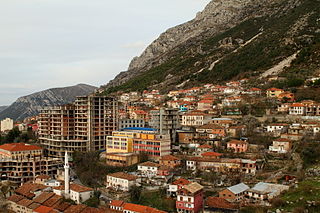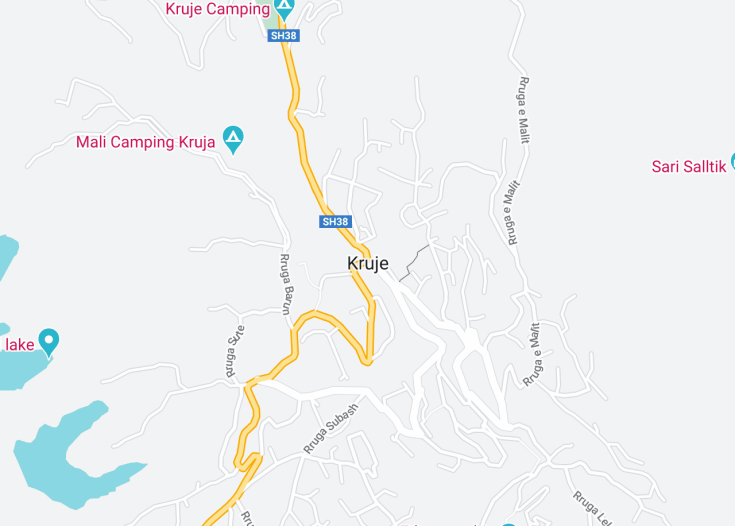Nestled in the heart of Albania, Krujë is a captivating town steeped in rich history and cultural significance. Famous for its role in the 15th century as the stronghold of Albanian national hero Skanderbeg, it offers visitors a unique glimpse into Albania’s past through its well-preserved castle, traditional bazaar, and museums. The town’s dramatic setting on a mountain plateau also provides breathtaking views of the surrounding landscapes, making Krujë a must-visit for those interested in history, culture, and natural beauty.
Make sure to visit Krujë Castle, not only for its historical significance but also for the panoramic views of the Albanian landscape from its towers.
Explore the Old Bazaar to find unique handicrafts and souvenirs that encapsulate the spirit of this historic town.
Top things to do & see in Krujë
Select the following sights and activities to discover best tickets and tours available in Krujë.
Krujë: A Glimpse into Albania’s Proud History
| Country | Albania |
| Time in Krujë | GMT+1 |
| Language spoken | Albanian |
| Population | 20,045 (INSTAT, 2021) |
| Currency | Albanian Lek (ALL) |
| Airports |
|
Krujë, Albania, is steeped in rich history, prominently known for its resistance against the Ottoman Empire under the leadership of Skanderbeg during the 15th century. The town is located approximately 20 miles north of the Albanian capital Tirana, perched on the slopes of Krujë Mountains which offers spectacular views of the surrounding area. Its historical significance is enshrined within the walls of the Krujë Castle, which today houses the National Skanderbeg Museum, drawing enthusiasts of history and culture alike.
Aside from its historical landmarks, Krujë is famous for its old bazaar. The market street has been a center of trade since the 15th century and continues to charm visitors with its variety of handmade crafts, traditional costumes, and antiques. This pedestrian street, lined with small shops housed in authentic Ottoman-style architecture, offers a journey back in time. It’s not just a place to buy traditional goods but to experience the spirit and perseverance embedded in Krujë’s history.
Krujë’s significance extends into the spiritual realm with the Sari Saltik Kulliye, a Bektashi religious complex offering insight into the mystical practices of Sufism in Albania. Surrounding natural attractions like Mount Krujë provide numerous trails for hiking and exploring, adding to the allure of Krujë as a destination that blends history, culture, and nature.
Despite its small size, Krujë plays a huge role in the national identity of Albania. It serves as a symbol of resilience and strength, representing the spirit of Albanian resistance through centuries. Visiting Krujë is not only about exploring its castles and old markets but experiencing a place that has profoundly shaped the historical narrative of Albania.
Where is Krujë?
Krujë is situated in north-central Albania, nestled against the Krujë Mountains and overlooking the coastal plains with scenic views.
Distances:
| Route | Distance by car | Time by car |
|---|---|---|
| Tirana to Krujë | 20 miles / 32 km | 40 minutes |
| Durrës to Krujë | 29 miles / 47 km | 50 minutes |
| Shkodër to Krujë | 55 miles / 88 km | 1 hour 30 minutes |
What is Krujë famous for?
Krujë is renowned as the stronghold of the national hero Skanderbeg, who valiantly resisted Ottoman invasions in the 15th century. The town boasts a well-preserved castle, historical museum, and a vibrant old bazaar that reflects its rich history.
History
Krujë, a captivating town in Albania, boasts a rich history that stretches from ancient times to modern-day prominence.
Antiquity to Middle Ages (Before 1190)
Archaeological discoveries suggest that the area around Krujë has been inhabited since prehistoric times. Various artifacts, including tools and pottery, indicate a significant Illyrian presence. The region was known for its strategic significance, which persisted throughout antiquity and into the middle ages.”
The Rise of the Principality (1190-1389)
The documented history of Krujë begins around 1190 when it was mentioned as a significant Byzantine fortress. The town became part of the Principality of Arbër and later fell under the rule of various feudal families. Its strategic location made it a focal point during conflicts between the Byzantines and the emerging Balkan kingdoms.
Ottoman Conquest and the Era of Skanderbeg (1389-1478)
Krujë’s most illustrious period began when Gjergj Kastrioti, or Skanderbeg, took control in 1443, rebelling against the Ottoman Empire. Skanderbeg’s resistance made Krujë a symbol of Albanian resilience, particularly during the sieges when the town repelled multiple Ottoman invasions. Krujë finally fell to the Ottomans in 1478, years after Skanderbeg’s death.
Under Ottoman Rule (1478-1912)
With the Ottoman conquest, Krujë became an important administrative center. The town saw the construction of many architectural projects, including mosques and baths, integrating Ottoman cultural elements with local Albanian traditions. During this era, Krujë was also renowned for its bazaar, which was a significant trading hub in the Balkans.
Modern Krujë (1912 to Present)
In the modern era, especially following Albania’s independence in 1912, Krujë has developed into a symbol of national pride, largely due to its historical association with Skanderbeg. Today, it is a vibrant city that cherishes both its ancient roots and its role in the cultural and historical narrative of Albania.
Visit Krujë
What to see and do in Krujë, Albania.
There is a wealth of historical and cultural attractions to explore in Krujë. Visitors should not miss the Krujë Castle, which houses the National Skanderbeg Museum and the Ethnographic Museum. The old bazaar, reconstructed to reflect its original 18th-century appearance, offers a unique shopping experience with a variety of traditional crafts.
- Krujë Castle
- National Skanderbeg Museum
- Ethnographic Museum
- Old Bazaar
Festivals and Events in Krujë
Krujë hosts several cultural events and festivals throughout the year, particularly celebrating Albanian history and tradition. Notable events include the Skanderbeg Commemoration Day, which features reenactments and cultural performances in May, and the Krujë Festival, celebrated with traditional music and dance in October.
Best time to visit Krujë
The best time to visit Krujë is during the spring (April to June) or early autumn (September and October) when the weather is pleasant, and the cultural festivals add an extra layer of charm to the town’s picturesque settings.
Is Krujë worth visiting?
Krujë is unquestionably worth visiting for anyone interested in history, culture, and traditional Albanian life. The town’s iconic castle, rich museums, and vibrant bazaar offer a deep dive into the heart of Albania’s storied past, all set against the backdrop of stunning landscapes. Krujë’s ability to maintain its historical essence while offering modern amenities makes it an attractive destination for all types of travelers.










